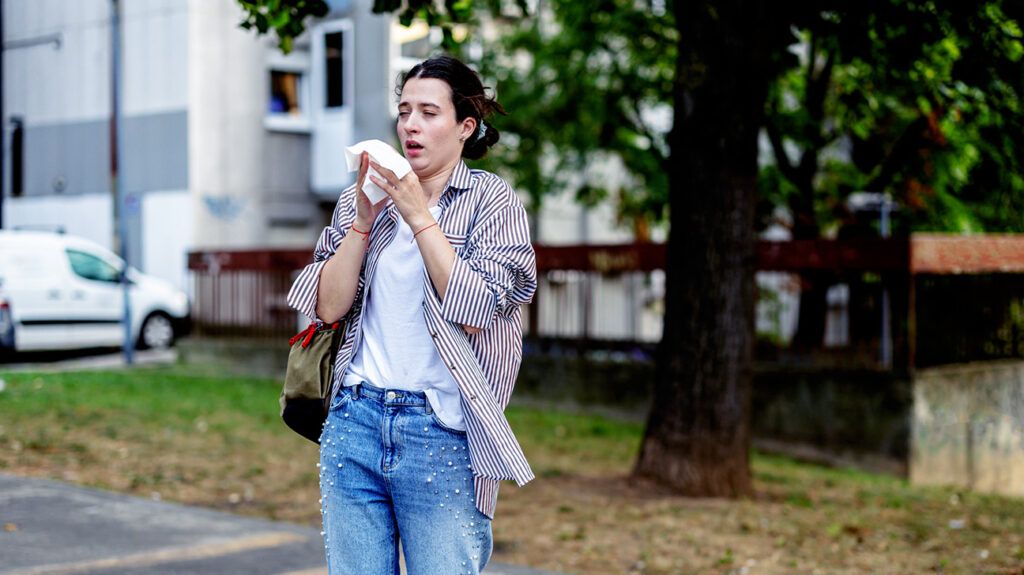The photic sneeze reflex causes a person to sneeze in response to sudden exposure to bright light, such as when going outside into the direct sun.
Another name for the photic sneeze reflex is autosomal dominant compelling helio ophthalmic outburst (ACHOO) syndrome. It follows a dominant pattern of inheritance. This means that if one parent has the reflex, a child has a 50% chance of inheriting it.
It is not a disease, and symptoms are usually mild. For some people, though, the sneezing is intense and uncontrollable.
Read on to learn more about the photic sneeze reflex.

The
For some people, the reflex is intense and forceful, causing repeated and uncontrolled sneezing. Doctors do not understand the mechanisms underlying this reflex nor what purpose it might serve.
It is very common, affecting 18–35% of Americans. Some studies put the rate even higher. For example, a 2017 German study found a prevalence rate of 57%.
People experience symptoms immediately upon sudden exposure to bright light. This might occur, for example, when a person is driving and turns toward the sun or goes outside into bright sunlight.
The photic sneeze reflex is almost certainly genetic.
Researchers do not believe that a single gene causes ACHOO syndrome. Rather, the phenotype — the manifestation of the underlying genetics — follows a dominant inheritance pattern. However, scientists have not yet untangled the genetics underlying this phenotype.
A
The same study did not find any link between ethnicity and the prevalence of photic sneeze reflex.
There is no cure for the photic sneeze reflex and no medical treatment. Instead, treatment focuses on reducing sudden exposure to bright light, especially among people for whom such exposure could be dangerous, such as pilots or drivers.
- wearing a sun hat
- wearing sunglasses
- using sun visors in a car
- being mindful of the time of day, how bright it is, and whether sneezing might pose any safety hazards
Sneezing alone is not harmful or dangerous, though repeated sneezing may be annoying. The main risk of the photic sneeze reflex is that it may disrupt a person’s ability to focus. This is more likely when a person has uncontrollable sneezing episodes rather than a single sneeze.
People driving, operating heavy machinery, or flying a plane have a heightened risk of accidents if they have a severe, pronounced photic sneeze reflex.
It is also possible that the photic sneeze reflex may co-occur with other medical conditions or risk factors.
Link to trigeminocardiac (TCR) reflex
A 2019 paper argues that the fifth and tenth brainstem nerves play a role in the photic sneeze reflex. This is similar to another reflex, the trigeminocardiac (TCR) reflex.
TCR causes a sudden heart rate drop and may also lead to:
- changes in digestion
- slow or stopped breathing
- low blood pressure during stimulation of the sensory branches of the central nervous system
Researchers have linked TCR to sudden infant death syndrome (SIDS), stroke, sleep disorders, and potentially other medical conditions. So it is possible that photic sneeze reflex could correlate with a higher risk of these conditions, be a manifestation of TCR, or share similar genetic risk factors, but more research is necessary.
The photic sneeze reflex is usually a mild annoyance. Some people may not even realize they have it or assume it is the typical reaction to bright light.
For some people, however, exposure to bright light may trigger uncontrolled sneezing. This can be frustrating and painful. It can disrupt daily life and potentially even pose safety issues, especially for drivers and pilots.
People with extreme reactions to light should adopt strategies to reduce sudden exposure to bright light. It may also be helpful to consult with a doctor about additional options, as research into this syndrome is ongoing.
